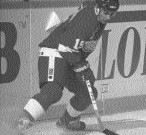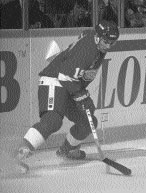Ready… Set… Stop!

Ready… Set… Stop!
By Robby Glantz
Nov 6, 2001, 20:29
 |
| Yzerman: A skilled stopper. ©BBS |
If you are a frequent reader of this column, you are no doubt aware that I am constantly striving to teach you what it takes to attain more speed while skating. And hopefully, by now, you are beginning to master some of these techniques for speed. With that in mind, the question we’ll address here is: ‘“Now that I’m getting all this speed, how about helping me learn to stop?”
That’s a very logical question, so let’s examine some methods that will improve your ability to perform the so-called “hockey stop.”
Forward Stop
In ice hockey, as you are surely aware, the change of direction using the quick stop—both forward and backward—is a vital fundamental. You must consistently work on and practice this very difficult skill, no matter what your level of play, in order to see marked improvement. And as with any other skating skill—because you are pushing yourself to get better—you are going to need to do your share of falling down while practicing. But do not look on this as a failure. In fact it’s just the opposite; it means that you are getting closer to stopping properly now that you are breaking out of your comfort zone.
Here are some tips to keep in mind while working on your forward stop:
• Bend your knees so deep that it feels like your going to sit your butt back on the ice.
• Keep your eyes forward, your chin up and your back straight.
• Be sure to turn your hips 90° (a 1/4-turn) from the direction you were traveling, with both skates turning at the same time.
• In making the stop, the outside skate should slide along the top of the ice on an inside edge, with the snow coming off the middle-front part of the skate (the ball of your foot).
• The inside skate should trail the outside one and also slides on top of the ice, but on an outside edge. Again, the snow should be coming off the middle-front part of the edge.
• Your feet should be staggered at this point (not heel-to-toe even), with the inside foot in front of the outside foot by almost a full skate length.
• Body weight should be distributed with the greater percentage to the outside skate (inside edge). If not, and you have too much weight over the inside foot (outside edge), then the skates will slide out from under you causing you to fall or lose your balance.
• Be sure to counterbalance the stop with your upper body, by keeping your shoulders parallel to the ice, rather than leaning or dropping the inside shoulder down towards the ice.
Skating Imagery: When performing the hockey stop, it is important that you think of it more as a hockey “slide” first, and a hockey “stop” second. In other words, do not put the cart before the horse. Too many players think they can come to a screeching stop as if, for example, they are changing directions on a basketball court. However, when you watch the most skilled stoppers in the NHL, such as Wayne Gretzky or Steve Yzerman, in slow-motion, you will realize that they actually slide their skates along the top of the ice before they come to a stop.
An “off” side?
Finally, when teaching the art of the hockey stop, inevitably someone asks the question about why one stopping side is stronger than the other. And it should be noted that every pro player I have ever worked with has a weaker side, not only when stopping, but when turning and performing other maneuvers as well.
The only way we have found to make your bad side stronger is to work harder on it, and not to ignore it just because it becomes frustrating. But to take that one step further, really try to focus and concentrate on exactly what it is you do on your good side that allows you to perform the maneuver well. Once you have the steps sorted out in your head, it should then be easier for you to transfer those same techniques to your weaker side.
Robby Glantz, power skating coach for the Los Angeles Kings, Swedish champions Malmö, and the German National Teams, conducts skating programs throughout North America and Europe.
This first appeared in the 12/1995 issue of Hockey Player Magazine®
© Copyright 1991-2001 Hockey Player® and Hockey Player Magazine®

